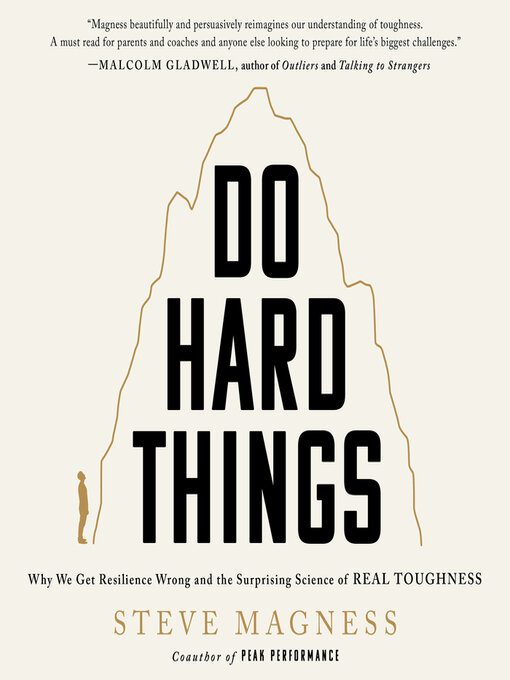Real toughness is experiencing discomfort or distress, leaning in, paying attention, and creating space to take thoughtful action. It’s navigating discomfort to make the best decision you can.
The Do Hard Things book is based on Steve Magness’s experience—in working with elite athletes across professional sports, as well as executives and entrepreneurs in the workplace—and partially through the latest science spanning the fields of cognitive psychology, neuroscience, and physiology.
In Do Hard Things: Why We Get Resilience Wrong, and the Surprising Science of Real Toughness, performance scientist Steve Magness argues for a reimagination of our understanding of toughness. Drawing from mindfulness, military case studies, sports psychology, neuroscience, psychology, and philosophy, Magness provides a roadmap for navigating life’s challenges and achieving high performance that makes us happier, more successful, and, ultimately, better people.
Façade of Toughness
In trying to toughen through callousness, we’ve trained ourselves to respond to fear and power. The reason we push through discomfort is because we imagine someone is standing over us yelling, or that if we fail, we will face punishment. We’ve been conditioned to see the external as more important than the internal, and that putting on a facade of toughness (“I’m not afraid of anything!”) is more important than how we handle difficult times. Remove the fear, power, and control, and our “tough” individual is left without the necessary skills to navigate adversity. The old view of toughness gives him a hammer and expects him to bash his way through any problem. But truly being tough isn’t the same as being callous.
Fake toughness is easy to identify.
“It’s the appearance of power without substance behind it. It’s the idea that toughness is about fighting and ass-kicking. It’s the guy picking a fight at your local gym. The anonymous poster acting like a hard-ass on message boards. The bully at school. The executive who masks his insecurity by yelling at his subordinates. The strength coach who works her athletes so hard that they frequently get injured or sick. The person who hates the “other” because that’s a lot easier than facing their own pain and suffering. The parent who confuses demandingness for discipline. The coaches who mistake control for respect. And the vast majority of us who have mistaken external signs of strength for inner confidence and drive.”
Real Toughness
Real toughness is experiencing discomfort or distress, leaning in, paying attention, and creating space to take thoughtful action. It’s maintaining a clear head to be able to make the appropriate decision. Toughness is navigating discomfort to make the best decision you can. And research shows that this model of toughness is more effective at getting results than the old one.
Fake vs Real Toughness
“Real toughness is about providing the tool set to handle adversity. It’s teaching. Fake toughness creates fragility, responding out of fear, suppressing what we feel, and attempting to press onward no matter the situation or demands. Real toughness pushes us to work with our body and mind instead of against them. To face the reality of the situation and what we can do about it, to use feedback as information to guide us, to accept the emotions and thoughts that come into play, and to develop a flexible array of ways to respond to a challenge.”
Toughness is having the space to make the right choice under discomfort
TOUGHNESS MAXIM
- Real toughness is experiencing discomfort or distress, leaning in, paying attention, and creating space to take thoughtful action. It’s navigating discomfort to make the best decision you can.
- Our appraisal of a situation as a threat or as a challenge depends on the perceived demands of that stressor versus our perceived abilities to handle them. Do we have the resources to handle the demands?
The Four Pillars of Real Toughness
- PILLAR 1: Ditch the Facade, Embrace Reality
- PILLAR 2: Listen to Your Body
- PILLAR 3: Respond Instead of React
- PILLAR 4: Transcend Discomfort
Our brain is an uncertainty-reducing machine
Our brain is an uncertainty-reducing machine, willing to do whatever it takes to minimize surprise, even if it is at a high cost. Whenever we face something that throws our internal state off-kilter, we go about trying to solve it. We seek out a solution that moves disorder to order. Sometimes that means giving up, such as when we are a third of the way through a project and can’t see the finish on the horizon. We often quit so that the unknown becomes the known. Other times it means changing our expectations before even beginning a task. Or it could mean exploring, accepting, or avoiding whatever it is that has led to unease or discomfort. Uncertainty demands a conclusion. We have an innate need for closure, however we can reach it.
“Toughness is about making the pull for closure amid uncertainty work with you, not against you. It’s training the mind to handle uncertainty long enough so that you can nudge or guide your response in the right direction. To create space so that you don’t jump straight from unease to the quickest possible solution, but to the “correct” one.”
All the Best in your quest to get better. Don’t Settle: Live with Passion.

Comments are closed.